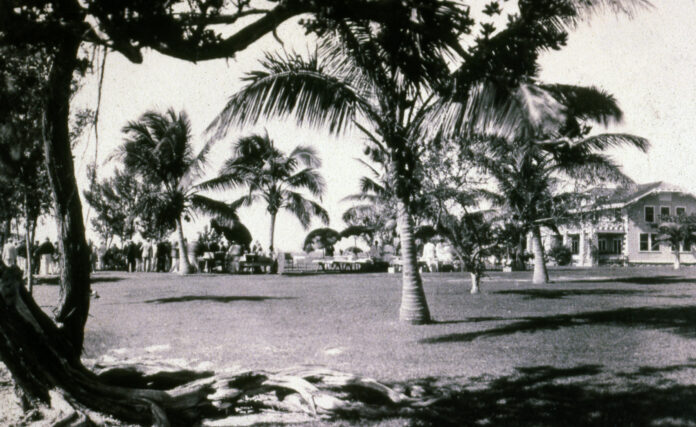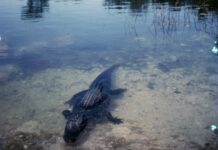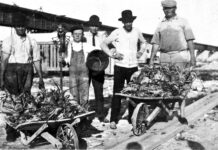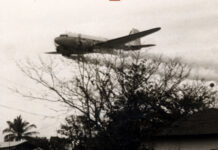Coccoloba diversifolia is a native tree that produces a small reddish-purple fruit that my dog, Beau, likes to eat on our morning walks. Birds and other small mammals like to eat them, too, which is one reason one of the common names for the tree, and the fruit, is pigeon plum.
Pigeon plum can be eaten out of hand but is often made into jelly. It can also be used to make wine or distilled into a more potent beverage, a drink that has caused the pigeon plum also to be called the tie-tongue tree.
There is an island in the Florida Keys called Cocolobo Key – at least it was called that once or twice by mistake. Its real name is Adams Key, which dates back to at least the 1862 U.S. Coast & Geodetic Survey that shows the identifier. The island has an interesting history, some based in fact and a bit that alludes to a connection with a local legend that has confounded and confused the historical record for centuries.
Some people have said that Adams Key served as the hideout for the legendary pirate Black Caesar, and Biscayne National Park has erected an interpretive panel alluding to the pirate’s history at a spot that overlooks the creek flowing between Old Rhodes and Elliott Keys, where an islet bearing the pirate’s name breaks through the surface. The creek, by the way, Caesars Creek, also bears his name. By most accounts, the pirate or pirates operated from a lair on Elliott Key – but Black Caesar is a tale for another day.
Adams Key was not much of a topic of conversation before the 20th century. It was not until after the turn of the century that the island began to build its notoriety as an exclusive fishing club that hosted Washington’s elite, including several presidents. It did not start that way.
As far as early ownership, the history appears to be a little murky. A report printed in the Tampa Daily Times on March 27, 1914, stated: “Land on Key Largo and Elliot’s key, the principal lime keys, has been selling fast this spring, among the purchasers being W.N. Hull, 240 acres; H.G. Ralston, 140 acres; Earl Fonda, 120 acres, being the whole of Adams key.”
Clearly, not all of that acreage was on the relatively small island listed in various newspaper articles as 79 acres, 77 acres, and 28 acres. It is also possible that the island purchased by Mr. Fonda was misidentified, as the general history told about Adams Key is that it was owned by a man identified as Jeremiah Saunders. A Bahamian from Green Turtle Cay, Saunders received a land grant for acreage on Elliott and Adams Keys in 1886.
What he did on Adams Key is unclear, but on Elliott Key, he did what Elliott Key is perhaps best known for: he grew pineapples. According to a 1900 report published in the Florida Times Union, Saunders shipped 6,000 dozen red Spanish pineapples and 500 dozen Puerto Rico pineapples from his farm at Elliott Key.
The history of Adams Key began to develop in earnest when Saunders sold Adams Key in 1917, or at least that is the story often told about the island. If it was true that the island was sold to Carl Fisher in 1917, it makes a notice published in The Miami Herald on Oct. 2, 1916, a bit premature. The notice announced the application for a charter to form a not-for-profit social club called The Cocolobo Cay Club.
According to Article 1: “The name of the corporation shall be called ‘The Cocolobo Cay Club,’ and is said to be located on what is known as Adams Key.”
Article 3 stated: “Any white person of good moral character, eighteen years of age and over, shall be eligible for membership in said corporation.”
The board of directors consisted of Charles W. Kotcher, president; James. H. Snowden, vice president; Carl G. Fisher, secretary and treasurer; and W.E. Brown, and Frank B. Shutts.
A Jan. 14, 1919, article in the Miami News mentioned that Carl G. Fisher, Harry Stutz, and Robert Maypole of Miami Beach traveled from the mainland 40 miles south to Adams Key aboard Fisher’s “fast express cruiser,” the Shadow V. According to the article: “Cocolobo Cay, formerly known as Adams Key is owned by a few of those wealthy men, who have made it a beauty spot by erecting a commodious club house, building dockside facilities, and clearing up and improving the landscape.”
The New York Herald edition dated Jan. 30, 1921, posted a story about Fisher, the island, and the club. “The Cocolobo Club has a unique location. Carl Fisher, one of the most enthusiastic sportsmen in the southern part of the peninsula, established it a year ago on the spot where ‘Black Caesar,’ most famous of all Gulf pirates, used to make his headquarters in the buccaneering days of 1847.”
While the Black Caesar angle might not be anything more than a classic Florida Keys legend, the Cocolobo Cay Club became a playground for the elite, and that story will be explored in next week’s column.


























